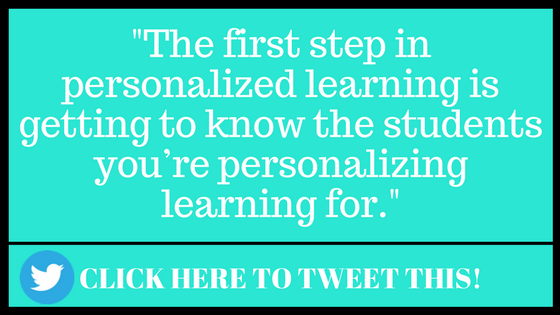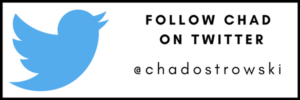Getting Started with Personalized Learning
Full Transcript Below
VIDEO TRANSCRIPT
Hey guys it’s Chad, and today I’m going to talk about something that is a buzzword that I’m hearing at conferences, meetings, and in almost every district I go to, and that’s getting started with personalized learning.
Now personalized learning, is trying to individualize and personalize the learning experience for every student in your class, and I know that this sounds like a really difficult and a hard concept to grasp, but it’s going to be okay. I’m going to give you four ways to get started on your journey to personalize classroom for your students.
The first step in personalized learning is getting to know the students you’re personalizing learning for. That means you’re going to have to get to know your students. Getting to know how they like to be assessed, how they like to learn, and access information, get to know what their interests are, what motivates them, this might take some time, especially at the beginning of the year, but it will be well worth it.
Another great tip to get to know your students, is having 1000 conversations about absolutely nothing. You’ll be amazed that if you just talk to your students in a non-academic setting, whether it’s recess, or the lunch line, or at a lunch table or during study hall, you will get to know them so well that you’ll be able to start to curate and tailor your instruction to be able to fit those interests and needs, and they’ll be more engaged in more focused for it.
The second way you can start to personalize learning in your classroom is to provide choices for your students. Provide choices in a in how they show mastery, provide choices and how they receive information, how they interact with it, provide choices on where they can sit, all these things can help personalize the learning experience for students in your class and they’re not that hard to implement.
The third thing I want to discuss, is consider self paced or mastery learning. These type styles of learning, allow students to work at their own pace in only to move on when they’ve shown mastery of a concept. By using pace as the tear one intervention to prevent students from moving on your automatically personalizing the experience, this’ll make additional individualization or personalization so much easier because you’re going to be able to meet each student where they are in their current level of mastery.
The last and final step that is in with any educational initiative is set your systems and routines. Something I’ve always said is the more freedom, flexibility, or personalization you provide your students, the more structure, systems, and routines have to be in place. That’s because, if you want a purposeful classroom, you have to make sure it’s a managed classroom, because a managed classroom is a productive classroom.
So if you want to provide more freedom and individualization for your students, make sure you set routines for things like when a students have questions, when they need help, how they access their resources, where they go to get help when they need it. Is there a system for peer to peer instruction? Or do they need to move seats, or go to a different activity or make a different choice.
Make sure you’re thinking through every possible scenario so that you don’t create bottlenecks or management issues in your classroom, because I know students that centered instruction can be stressful sometimes, it can increase some of those management issues if the structures and routines aren’t set up on the backend.
So if you’re thinking about personalized learning, which I hope you are because it’s a fantastic way to meet the needs of individual students. I want you to think these four steps, get to know your students, provide choices, consider self pacing or mastery, and make sure you have the systems and routines set up to be successful.
Thank you so much for taking the time to teach better with me today. Stay awesome and have a fantastic week.




